Smarter Testing: Setting New Standards for Operational Safety of Structural Glazing Adhesive Sealants

Nikada / E+ via Getty Images
Structural glazing adhesives have become indispensable in modern architecture, enabling the creation of glass façades that marry sleek designs with exceptional load-bearing capabilities. These high-performance materials are subjected to stringent demands for safety, durability, and aesthetics, with only a select few products passing rigorous approval processes to qualify for use. Typically, these adhesives consist of two-component silicones, carefully engineered to meet exacting industry standards.
Despite their importance, the methods traditionally used to evaluate these adhesives often fail to capture the full scope of their performance. Standard industry tests, such as the H-Piece tensile test or manual peel assessments, remain dominant in certification processes. However, these methods rely on basic measurements and visual evaluations, which offer only a partial understanding of adhesive failure behavior - neglecting critical factors like delamination resistance or load bearing stability under varying multi-mode loading conditions.
Emerging advancements in failure analysis are now transforming the landscape of adhesive testing. Sophisticated techniques, such as the MCT method pioneered by FRACTURE ANALYTICS, delve deeper into parameters like fracture resistance or bond stability. These cutting-edge tools reveal insights into adhesive behavior that traditional methods simply cannot match, providing a more accurate and detailed assessment of operational performance.
This shift underscores the increasing recognition of the need for modernized evaluation methods in structural glazing. But how can these advancements be leveraged to address current testing gaps effectively? The following section explores this question, shedding light on the potential of advanced failure analysis to redefine safety and reliability standards in adhesive sealants.
Revisiting Traditional Testing Methods: Why They Fall Short for Modern Adhesive Applications
Structural glazing adhesives play a crucial role in contemporary building design, particularly in high-performance applications like attaching glass to façades. Historically, these adhesives have been evaluated using standardized methods that have remained largely unchanged for decades. Tensile and shear tests, such as those described in ASTM C1265-06 [1] or ISO 8339 [2], continue to dominate as benchmarks for assessing adhesive strength and durability. Accelerated weathering tests, designed to simulate the effects of UV radiation, heat, and moisture, further complement this testing approach [3-7].
While these traditional methods offer foundational data, they fall short of capturing the complex interactions and failure modes seen under realistic conditions. Adhesive bonds in structural glazing are exposed to stressors such as wind loads, thermal expansion, and fluctuating environmental conditions, all of which can initiate intricate interfacial failure mechanisms. Current testing methodologies based on strength evaluation, however, fail to account for these subtleties, leaving critical gaps in our understanding of adhesive performance.
In response to these limitations, modern testing innovations are reshaping how adhesive reliability is assessed. Techniques like the fracture-energetical GF-method, pioneered by FRACTURE ANALYTICS [8-13], introduce a level of analytical precision that traditional tests cannot achieve. By focusing on different failure processes such as interfacial crack formation, initiation and propagation, these advanced methods provide a more comprehensive perspective on adhesive performance, especially under multiple loading scenarios.
This paradigm shift in evaluation methodologies underscores the necessity for industry-wide adoption of more robust tools. However, as new insights emerge, the question remains: how can these advancements be effectively integrated into current testing standards? The next section delves deeper into this challenge, exploring how a modernized approach can redefine performance benchmarks in structural glazing adhesive evaluations.
Navigating Evaluation Methods for Structural Glazing Adhesive Sealants
The lack of uniform, standardized evaluation methods addressing failure behaviour of adhesive sealants has left manufacturers of structural glazing adhesives to devise their own quality assurance protocols. This has resulted in a fragmented landscape where different brands follow unique procedures. Take, for example, Dow - a key player in the adhesive industry alongside Switzerland's Sika. Dow’s ‘Silicone Structural Glazing Manual’ [14] outlines a comprehensive set of testing procedures aimed at ensuring adhesive performance under specified conditions.
These proprietary guidelines, such as those detailed in Table 1, serve as benchmarks for evaluating product quality. However, while these methodologies address basic performance measures, they often overlook the complexities of interfacial failure mechanisms and long-term durability under real-world conditions.
This gap in evaluation approaches calls for a closer examination of the existing testing methods and their limitations, which will be explored in the next section.
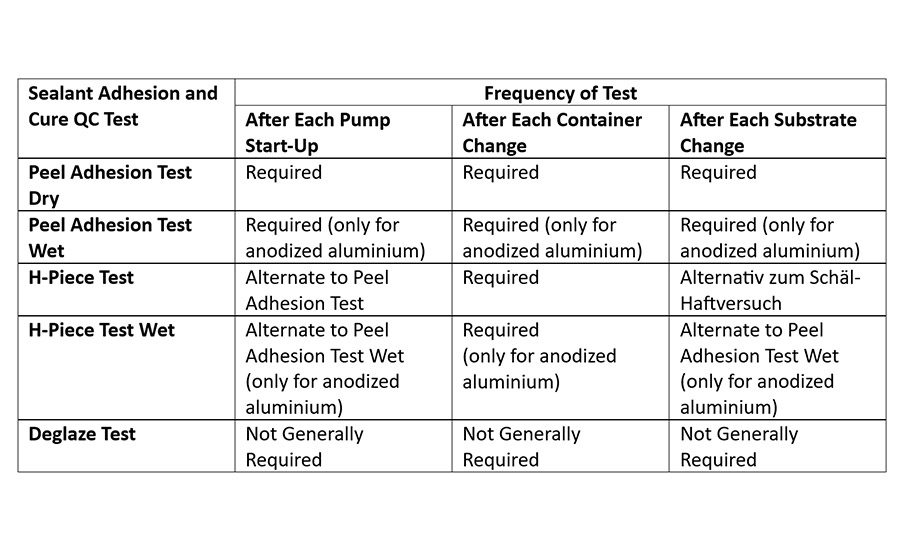
The Manual Peel Adhesion Test
The manual peel adhesion test is often regarded as a simple and accessible way to gauge residual adhesive bonding to a substrate through manual peeling, as depicted in Figure 1. While this method is commonly used as a quick on-site check for adhesion, its simplicity is also its greatest flaw.
The results from this test are highly inconsistent, as they are influenced by environmental factors and variations in how the test is performed. Moreover, it relies entirely on subjective, visual observations without generating measurable or reproducible data. From a technical standpoint, the test fails to deliver meaningful material parameters or insights into the adhesive's actual performance characteristics.
Given these significant limitations, this method is unsuitable for making informed decisions regarding adhesive selection or performance evaluation. A more robust and data-driven approach is essential to ensure reliable outcomes in demanding applications.
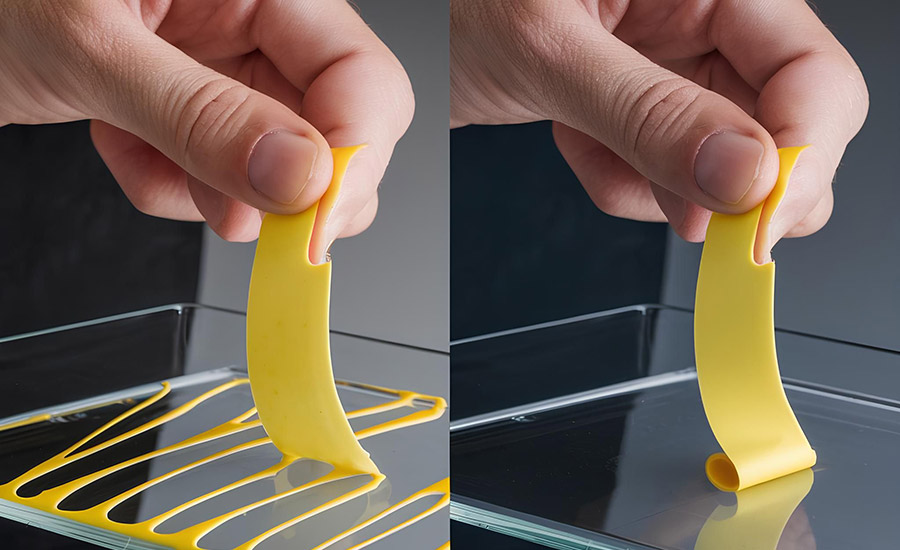
The H-Piece Test
The H-piece pull-off test, as outlined in ISO 8339 [2], is widely used but exhibits several limitations when compared to advanced evaluation methods like interfacial fracture analysis. The primary drawback is that this test measures only the peak load at the point of failure for the bonded joint, not the interface. Moreover, it offers no insight into the adhesive's post-failure behavior or interfacial damage progression under sustained loading conditions.
Additionally, the test does not incorporate material modeling techniques, such as cohesive zone models, which are crucial for predicting the adhesive's behavior under variable stress scenarios. By focusing on the overall bonded structure rather than the critical adhesive interface, the test overlooks the specific bond line where failures typically originate.
These limitations make the H-piece pull-off test insufficient for the comprehensive evaluation of structural glazing adhesives. In applications where long-term performance and detailed material insights are critical, advanced testing methods are necessary to ensure both safety and reliability.
Material and Methods
This article explores nine distinct products designed for glazing applications, sourced from five different manufacturers. The evaluation follows a proprietary methodology rooted in interfacial fracture analysis, which has been extensively documented in prior research [8-13]. Table 2 outlines the specific details of the tested products. To analyze the interfacial bond performance and bond safety, four empirical evaluation parameters were employed. These parameters are explained in greater detail as follows, offering a structured approach to assessing adhesive performance.
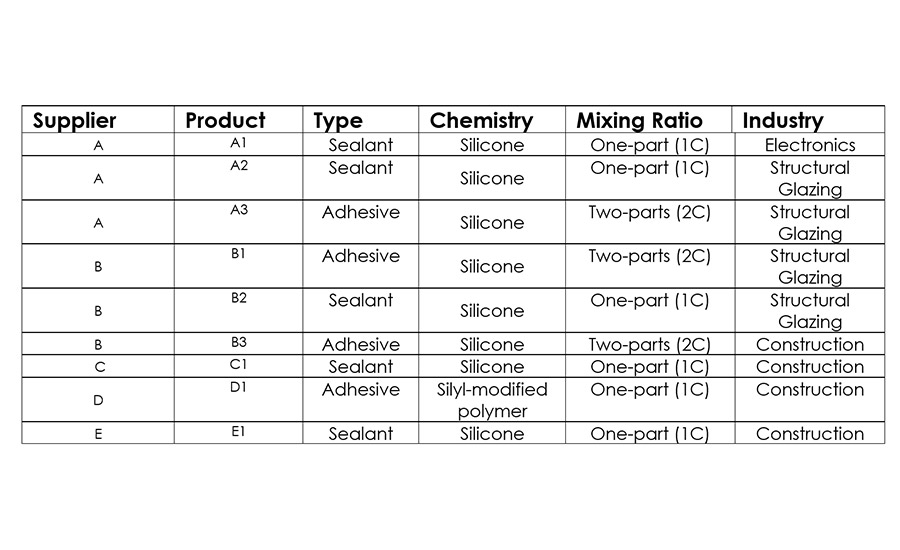
1. Interfacial Debonding Strength sc
This parameter evaluates the cohesive stress at the interface during crack propagation under different loading conditions. Unlike tensile strength, which measures bulk adhesive performance, σc focuses on the fracture behavior at the adhesive-substrate interfaces. Since real-world failures often originate at these complex interfaces, this method provides a more realistic and reliable assessment compared to simple tensile tests.
2. Interfacial Debonding Resistance GF
This fracture energy parameter quantifies a material's resistance to cracking during formation, initiation, and propagation under load. Measured in Mode I (crack opening) according to international standards, GF is an intrinsic material property that delivers deeper insights into adhesive performance than traditional tensile test.
3. Interfacial Load Stability (ILS)
Developed by FRACTURE ANALYTICS, ILS measures load consistency beyond the peak load during crack propagation. It evaluates whether the load remains above 90% of its peak value throughout propagation, focusing on stability after crack initiation. The results are recorded as relative values compared to maximum load displacement, offering a unique perspective on adhesive reliability.
4. Interfacial Bond Safety (IBS)
Created by FRACTURE ANALYTICS, IBS is a multi-parameter metric that evaluates overall bond safety under cracking conditions. It integrates key fracture analysis parameters to provide a comprehensive assessment of adhesive reliability. Further details can be obtained directly from the author.
Results and Discussion
The study’s findings on various elastic adhesives and sealants for structural glazing applications are summarized in Table 3, covering a diverse selection of manufacturers and products. Unlike typical product datasheets, which don’t provide detailed fracture analysis data, this study offers a first-of-its-kind comparative dataset within the adhesive industry. This is particularly relevant as manufacturers often present strength values based on different testing standards, making direct comparisons nearly impossible.
To highlight these discrepancies, Figure 2 contrasts the "Interfacial Debonding Strength" values from the FRACTURE ANALYTICS study with manufacturer-reported strength values derived from varying standards. The inconsistencies are striking - not only due to differences in test methodologies, which should not be directly compared, but also because they involve distinct products. This lack of a unified evaluation standard presents a challenge for users, as manufacturer data cannot be reliably used for specification purposes. Additionally, industry norms generally focus on basic strength values, failing to account for more demanding performance criteria.
Interestingly, the study also reveals that adhesives explicitly marketed for structural glazing do not always outperform alternatives. Some retail-grade SMP-based DIY products, such as D1 achieve similar performance depending on the evaluation metrics outlined. Likewise, cost-effective window glazing adhesives like B3 deliver competitive results. Despite these variations, all tested products demonstrated a consistently high standard, with no product receiving a rating below four stars.
For the interested reader, additional information can be obtained from Table 3.
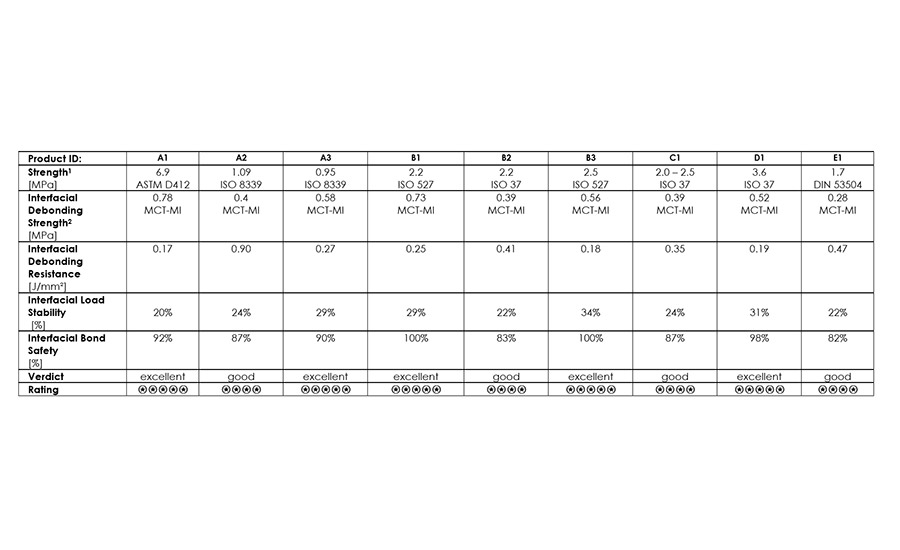
1According to datasheets from manufacturers.
2According to internal measurements by FRACTURE ANALYTICS.
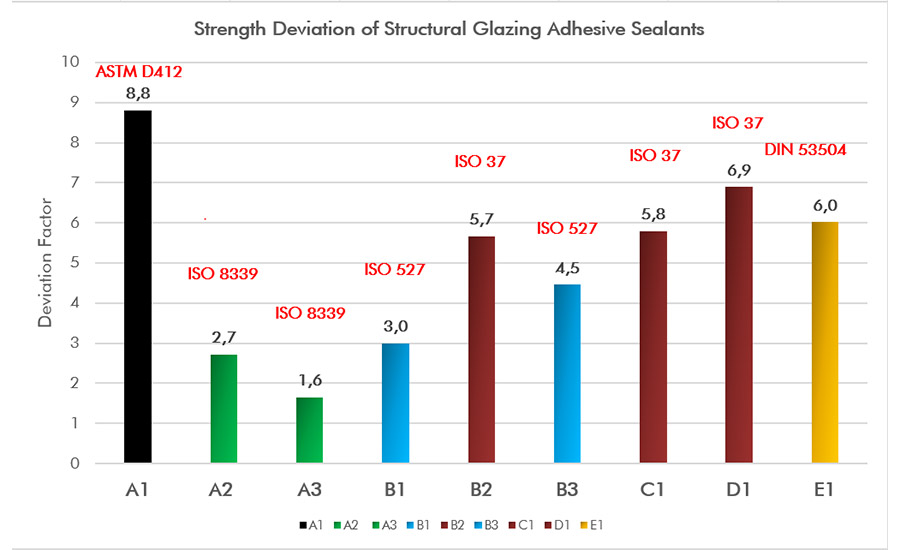
Conclusion and Future Perspectives
This study highlights the urgent need to modernize evaluation methods for structural glazing adhesives. Traditional approaches, such as the H-piece tensile test and manual peel assessments, have long been industry standards but fail to capture the complex interfacial failure mechanisms occurring under realistic loading conditions. By utilizing advanced multiparametric interfacial fracture analysis, this research provides a deeper and more accurate understanding of adhesive performance, revealing significant discrepancies between manufacturer-reported strength values and those obtained through empirical testing.
The introduction of new evaluation parameters shifts the focus from basic strength measurements to a more comprehensive assessment that includes crack initiation, crack propagation, and load stability during fracture. These insights are essential for ensuring the long-term reliability of structural glazing applications, particularly in demanding architectural environments.
Findings from this empirical study illustrate considerable variability in adhesive performance across different manufacturers, reinforcing the necessity for more sophisticated, fracture-based evaluation criteria. The comparison between fracture analysis data and conventional manufacturer specifications exposes the limitations of current industry practices and underscores the potential for substantial improvements in product selection and qualification.
By setting a new benchmark in adhesive testing, this research advocates for the adoption of advanced methodologies that offer greater precision and comparability. Implementing these improved evaluation techniques will enhance the safety and performance of structural glazing adhesives, ultimately benefiting both manufacturers and end-users by enabling the development of more durable and resilient bonded structures.
Learn more about FRACTURE ANALYTICS at www.fractureanalytics.com.
References
[1] ASTM C1265-06, Standard Guide for Evaluation of Structural Adhesives for Insulating Glass Edge Seals, ASTM International, West Conshohocken, PA, 2006.
[2] ISO 8339, Building construction — Sealants — Determination of tensile properties (Extension to break), International Organization for Standardization, 2005
[3] J.M. Klosowski, A.T. Wolf, Sealants in Construction, Second Edition, CRC Press (2015), ISBN 9781574447170.
[4] L.D Carbary, A Review of the Durability and Performance of Silicone Structural Glazing Systems, Glass Performance Days 2007, J. Vitkala (ed.), 190-193
[5] EOTA, ETAG 002 Structural Sealant Glazing Systems, Part 1: Supported and Unsupported Systems, European Organization for Technical Assessment, Brussels, Belgium (2012).
[6] R. Kaatz, C. Recknagel, Advanced Evaluation of Structural Sealant Glazing Systems by a New System Test Approach, ASTM STP 1583 (2015), DOI: 10.1520/STP158320140074.
[7] C. Recknagel, R. Kaatz, Exploration and Evaluation of the Performance and Durability of SSG Systems by Dynamic–Mechanical System Testing, ASTM STP 1583 (2015), DOI: 10.1520/STP158320140064
[8] M.H. Brandtner-Hafner, Assessing the natural-healing behavior of adhesively bonded structures under dynamic loading, Engineering Structures 196 (10) (2019) 109303, DOI: 10.1016/j.engstruct.2019.109303.
[9] M.H. Brandtner-Hafner, Structural safety evaluation of adhesive bonds: A fracture analytical approach, Engineering Failure Analysis 123 (5) (2021), 105289, DOI: 10.1016/j.engfailanal.2021.105289.
[10] M.H. Brandtner-Hafner, D. Díaz-Batista, Techno-economic evaluation of biocomposites: A fracture analytical approach, Engineering Fracture Mechanics 240 (12) (2020), 107346, DOI: 10.1016/j.engfracmech.2020.107346.
[11] M.H. Brandtner-Hafner, Fracture analytical assessment of polymeric foams, Materials Letters, 325, 132886 (2020), DOI: 10.1016/j.matlet.2022.132886.
[12 M.H. Brandtner-Hafner, Holistic structural analysis of polymeric foam systems, Construction and Building Materials 368, 130428, (2023), DOI: 10.1016/j.conbuildmat.2023.130428.
[13] M.H. Brandtner-Hafner, Adhesive Bonding Efficiency of Concrete Interfaces, Concrete Engineering International, 27 (1) (2023) 45-48.
[14] Dow, Silicone Structural Glazing Manual, (2018), 1-32.
Looking for a reprint of this article?
From high-res PDFs to custom plaques, order your copy today!





